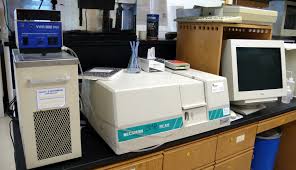Ad Blocker Detected
Our website is made possible by displaying online advertisements to our visitors. Please consider supporting us by disabling your ad blocker.

Ultraviolet-Visible Spectroscopy has continued to become center displaces exercise in almost every analytical lab. Since it was invented by Beckham and Cary back in 1940, UV-Vis Spectroscopy has transformed the molecular spectroscopy field. Over many years, most advancement have been made based on optical design, including noise suppression, integrated electronics, variable slit declaration, and dual-bean optics.
Options of detectors
The visual design and CCD footprint array spectrophotometer considerably differs from ordinary scanning spectrophotometers. A larger footprint needed to scan spectrophotometers is attributed to an increase in the optical surfaces necessary for isolation and dispersion of the required wavelength.
Additionally, most moving parts are essential for carrying out scanning functions, beam splitting, and slit selection. On the contrary, an array of CCD spectrophotometers transmits the whole wavelength via a previous wavelength isolation sample. The use of fixed granting outcome is position in the linear spectrum.

Light sources
The typical light source used in UV-VIS spectroscopy includes the quarts lamp tungsten for the visible wavelength from 350 nm to 1000nm. On the other hand, deuterium lamps are utilized for the UV wavelengths that are below 350nm. Xenon lamps are being used in the less expensive system but don’t provide stable or dedicated flexibility deuterium and tungsten sources.
Fiber optics
When the first visual capable system was invented, most critics mentioned the solarisation of the optical fibers and the sample photo-oxidation as the potential weakness of an array of the spectrographs. These are two myths that were dismissed quickly since the solarisation-resistant fibers that are usually used.
Options of sampling
The total number of the modern UV-VIS application system is limitless. As the day goes by, new uses are regularly discovered and implemented as versatility provided by many fiber-optic accessories samples. For instance, the custom UV-VIS spectroscopy is limited to liquid matrices using the standard 1-cm corvettes.
Software
The arrays of CC spectrophotometers have inherited the benefit of application flexibility. Since the entire spectrum is instantly made available and stored in the memory, the data can be repeatedly evaluated in various fashions—peak location, most spectrums overly, quantization, timed acquisition, and massive range overlay.
Timed acquisition
Kinetic analysis and timed acquisition are two of the software that CCD spectrophotometers that overwhelming beak scanning systems. Simultaneously, the full spectrum of data provides a significant advantage over the monochromatic system that seriously limits the data’s acquisition.
Quantitative analysis
The crucial advantage of the CCD system over the conventional scanning technology is that the arrays allow the simultaneous correction background at the user’s selectable location. The current trend of this requirement represents the traditional maturation of the technology of the UV-Vis Spectroscopy. Visit any of UV-Vis Spectroscopy the official site for more information.



